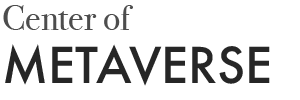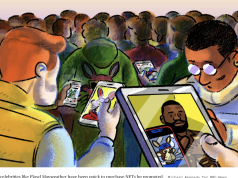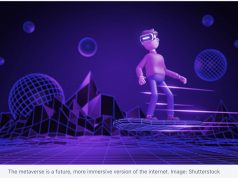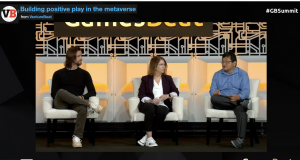Protocol, December 2021, Lizzie Lawrence
Hybrid work is the future, even though sometimes it sucks. A growing number of companies think the solution is the metaverse, but for work.
Most workers do not want to be in-person full-time, regardless of the pandemic and companies’ will-they-won’t-they office plans. Some major stakeholders want to improve remote and hybrid work by creating constant, digital spaces you can log into as some form of avatar. It’s a new definition of the virtual office.
It may be hard to imagine a large swath of employees sitting in a virtual room and bumping into digital forms of their colleagues all day. But many are already doing it, aided by online world builders like Gather, Teamflow and Virbela. Some even swear by it.
Who’s building the virtual office?
It seems like everyone, from Big Tech to shiny new startups, wants in. Microsoft plans to integrate its VR/AR platform Mesh with Teams and hinted at future “immersive spaces” within the messaging app. Meta built Horizon Workrooms to hold meetings with Oculus headsets. But as Protocol has previously noted: It’s the companies we’ve never heard of that are likely to make the work metaverse happen.
Virtual office companies were getting a lot of traction even before the explosion of the word “metaverse.” With mass adoption of remote work, startups smelled opportunity. Some have earned serious money from big-name investors. Gather, founded in May 2020, has raised $77 million, and Teamflow has raised $50 million since its January 2021 launch. Virbela, not a startup but a virtual world-builder since 2012, saw a 260% increase in revenue in the second quarter of 2020.
From the perspective of the companies building digital offices, there’s only upside. No more exorbitant real estate costs. Limitless design. Fully remote work with perpetually available social interaction. “I think the future is bright,” said Teamflow CEO Florent Crivello. “The transition to remote is going to be the most important economic transition since the Industrial Revolution.”
The metaverse as an embodied, interconnected network doesn’t exist yet. So these companies are building the next best thing: worlds you can move around in as a digital stand-in. The aesthetics vary. Gather looks like an old-school video game, with small, pixelated characters and a decorated 2D world. In Teamflow, you move around a modern-looking office as a floating circle of video. Virbela has a 3D design, letting you navigate through an office campus behind a full-bodied avatar. You can access Gather and Teamflow on your web browser, whereas users download the Virbela software — though the company is working on a web-based offering called Frame.  Pipo Saúde’s virtual office in Gather.Image: Pipo Saúde
Pipo Saúde’s virtual office in Gather.Image: Pipo Saúde
What does an office metaverse look and feel like?
All agree that virtual-reality technology is not advanced enough to be the entry point for the office metaverse. “I don’t think there’s an amount of money you can pay me to be in a VR headset 40 hours a week,” Virbela president Alex Howland said. The average person’s gut reaction to an avatar-based virtual office is already skeptical. Accessibility is key, and at the moment, solely using virtual-reality goggles would make it harder to win loyal customers. This realization is part of what jumpstarted Gather.
“I was so convinced of the metaverse and how much impact it would have, ready to buckle down and work on it for five, seven years and wait for VR to get better,” CEO Phillip Wang said. “That’s when the pandemic hit and there was a sense of, ‘Oh, we don’t need to wait that long. People need something urgently today.’”
Day-to-day office work is not the only use case for the metaverse. Gather’s been home to birthday parties, college reunions and major events like Forbes 30 Under 30 conferences. Virbela hosted the 2021 AfroTech conference and a 2020 holiday dance party where avatars lost their minds to Toto’s “Africa.” Teamflow also hosts virtual events, though its main focus is creating the best daily work environment possible.
Teamflow’s cardinal rules are spatiality, persistence and apps. Crivello explained that spatiality is when you’re heard only by those around you, the same way volume works in the real world. Persistence means that everything you’re working on stays in place when you close and reopen Teamflow. And apps are the collaborative integrations built into Teamflow, including Figma, Google Docs and Trello. Crivello sees Teamflow as a solution to tool fatigue. He doesn’t want you to have to leave Teamflow. And its users don’t seem to want to leave either — according to the company, the average customer uses Teamflow five days a week, six hours a day. This prompted the release of a redesign and mobile app in early November.
“We didn’t expect people to spend that much time in the product, obviously,” Crivello said. “It just became a place where they live.” A Teamflow conference combines video and a virtual room.Image: Teamflow
A Teamflow conference combines video and a virtual room.Image: Teamflow
Is my floating video bubble too close to your floating video bubble?
Virtual office worlds are ripe for many faux pas. I conducted interviews for this story within the platforms themselves and made some comical errors. At one point, I accidentally clicked on a faraway destination point and walked away from my interview subject, unable to return. Think about how regularly you or your colleagues mute-fail during Zoom meetings. Then think about teaching them how to control an avatar in a brand-new interface.
Real estate brokerage eXp Realty has been working virtually since 2009, when founder Glenn Sanford needed to cut costs after the housing market collapse. It cycled through different platforms until it came upon Virbela in 2016. The service was such a hit that its parent company acquired Virbela in 2018 after using it for two years.
“The first couple of visits, it’s uncomfortable. You might bump into a couple of walls, you might not know how to click on the seat and sit down,” eXp Realty CEO Jason Gesing said. But eXp employees quickly adapted to the platform’s quirks. Howland, Virbela’s president, compared the process to learning how to read. At first, all you see are the black and white characters on the page. Once you learn to read, you forget about the scribbles and focus on the meaning. “We want the virtual world to kind of go away, just like that,” Howland said. ![]() Virbela avatars chat on its open campus. Image: Virbela
Virbela avatars chat on its open campus. Image: Virbela
As with any new interaction on the internet, users might think about how social norms translate in a virtual office. Is my floating video bubble too close to your floating video bubble? Can my avatar wander into your office unannounced? A lot of it depends on the specific company’s policies — eXp Realty encourages drop-ins if people’s office doors are open. Employees at Brazilian health care startup Pipo Saúde like working at a shared desk within Gather so you can easily talk to employees without the emotional drain of sitting muted on a video call.
Surveillance is another valid concern. Companies already track employees through software and devices, leaving workers in a constant state of stress. If you gather all your employees and put them in one digital space, couldn’t that make tracking easier? Work metaverse companies vehemently oppose this usage, though employers can of course do it anyway. Workers should be able to come and go as they please, they say. “We see people using [Virbela] at all different levels,” Howland said. “It’s not a monitoring tool. At least, that’s not its intention.”
Easy adoption and customization are important for any new product, but particularly one that completely changes how we work. The virtual office builders consult with customers on their preferences and get the offices up-and-running. Then people can change the office space however they please. For more advanced adjustments, some offer consultations. Gather partners with other companies that can design a space for you.
“You have a world where people are really owning the experiences they create and what they have in this universe,” Wang said.  Pipo Saúde workers sit down in a Gather meeting room.Image: Pipo Saúde
Pipo Saúde workers sit down in a Gather meeting room.Image: Pipo Saúde
Sitting at your desk on your computer at your virtual desk
Some versions of the work metaverse allow for brief forays, like Shopify Party, Shopify’s Animal Crossing-esque meeting and gaming platform. But when a company commits to a virtual office, it only works if workers are there full-time. Agreeing to essentially live in a virtual world throughout the workweek is scary. It freaked out some workers at Pipo Saúde, which started using Gather in 2020 after deciding to become remote-first.
“A lot of people said, ‘I don’t want to be in Gather, I want to be disconnected, I want to be totally focused,’” said Manoela Mitchell, Pipo Saúde co-founder and CEO. But the tide turned as people grew accustomed to it, keeping it open in their browser and turning on mics/cameras when necessary. It helped people socialize and reduced the time of meetings. “We want one-minute alignments to be one-minute alignments, not 50-minute calendar events,” Mitchell said. The freedom of movement and accessibility of people within the office won Pipo Saúde’s employees over.
“We decided to do it because we want people to have spontaneous conversations,” Mitchell said. “And people love it.”
Others might think, what’s the point of sitting at my physical desk on my computer, only to log onto a virtual desk? Why use the internet inside a virtual office when you can just use the internet? Trello co-founder and metaverse enthusiast Michael Pryor agrees that when thinking about using these tools individually, it’s kind of silly. When everyone else is at the virtual desk with you, that’s when it becomes a game-changer. “Being together and working on our own things is actually very valuable and provides that opportunity for us to have random conversations with people,” Pryor said.
The ultimate goal is translating the advantages of the in-person office to a digital world. In solving for that goal, Pryor says that we’re going to see some funky and creative ideas. He compared it to people’s visions for dishwashers. “When they predicted dishwashers, they would describe them as robots, like you see on the Jetsons,” Pryor said. “And you’re like, OK, yeah, that didn’t happen. But we have dishwashers. They just don’t look like that.”
The future digital office faces a similar fate. You might not log into work in a SimCity-type office or as a floating head. But someday, maybe we’ll all work in digital offices that allow for tangible, immersive connection with co-workers all over the world.









